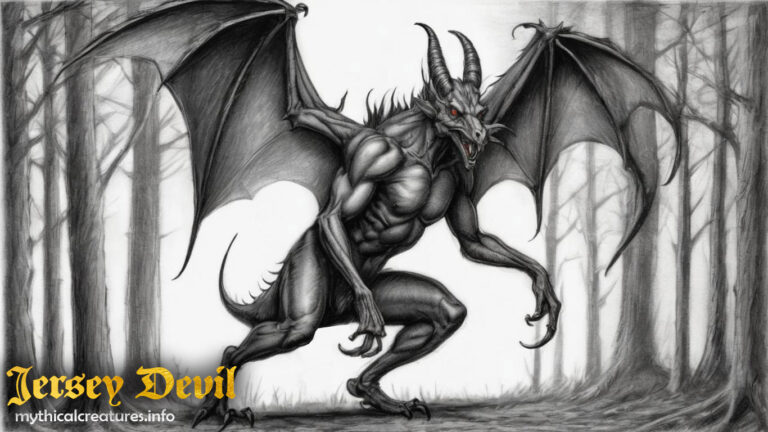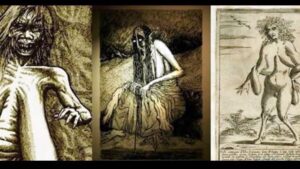Table of Contents
The Jersey Devil is a mythical creature from American folklore, said to inhabit the Pine Barrens of New Jersey. Described as a winged, hoofed, and horned creature, it’s the subject of various legends and sightings, though no concrete evidence of its existence exists. The creature’s origin dates back to the 18th century, and it remains a popular topic in cryptozoology and local lore.
Appearance
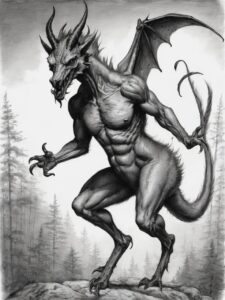
The Jersey Devil is typically described as a creature with the following features:
Wings: It is often said to have bat-like wings.
Hooves: Hooves similar to that of a horse or goat.
Horns: Antler-like horns on its head.
Tail: A long, forked tail.
Clawed Hands: Sharp claws on its hands.
Horse-Like Head: Sometimes, it’s described with a head resembling that of a horse.
Leathery Skin: The skin is often described as leathery or reptilian.
Mangy Fur: In some accounts, it’s said to have mangy or unkempt fur.
Origins
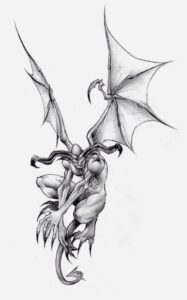
The origins of the Jersey Devil legend date back to the early 18th century in the Pine Barrens of New Jersey, USA. The most widely recognized version of the story attributes the creature to a woman named Mother Leeds, who was rumored to be a witch. According to the legend, she gave birth to her thirteenth child under a curse, and the child transformed into the Jersey Devil shortly after its birth, fleeing into the Pine Barrens.
Over the centuries, the legend of the Jersey Devil has evolved, with various sightings and accounts contributing to its lore. While people widely regard the creature’s existence as unproven and consider it a folklore tale, it continues to captivate the imaginations of people in the region and beyond, establishing itself as a part of American cryptozoology and pop culture. The Jersey Devil frequently associates with superstitions, strange occurrences, and eerie sightings in the Pine Barrens.
It All Started with an Almanac
In 1677, a man named Daniel Leeds arrived in the American colonies and settled in Burlington, now located in the Pine Barrens of New Jersey. Over the years, Daniel became increasingly involved in the Quaker community where he resided. Eventually, he collaborated with one of the first printers in the colonies to create an almanac, marking the beginning of a tumultuous chapter.
Although the majority of the almanac’s content was acceptable, it contained references to astrology that infuriated many community members who vehemently opposed mysticism. Accusations of occultism were hurled at Daniel Leeds. However, rather than yielding to community pressure to remove the astrological references, Leeds doubled down on the publication of German mysticism.
This decision led to a series of escalating problems. Leeds continued to publish material that was seen as anti-Quaker, further fueling the community’s anger and disgust. Moreover, when the colonists began opposing British rule in America, Daniel Leeds took the opposing side. He provided counsel to Lord Cornbury, the British Governor of his territory, and openly supported British rule. This enraged the community even more, viewing it as another transgression by Leeds, to the extent that they published a tract accusing him of consorting with the devil.
Benjamin Franklin Gets Involved
Eventually, in 1716, Daniel Leeds retired from almanac-making and passed the company on to his son, Titan Leeds. Titan assumed control of the family business and continued publishing the almanacs, complete with mysticism, largely without competition. However, this period of relative tranquility came to an end when Benjamin Franklin published his inaugural edition of ‘Poor Richard’s Almanac’ in 1732.
There was minimal direct confrontation between the two until the 1733 edition, when Benjamin Franklin boldly predicted the day of Titan Leeds’ demise. As anticipated, this audacious claim greatly incensed Titan Leeds, prompting him to launch an attack on the credibility of the new publisher by labeling him a ‘fool and a liar.’ Franklin, still in his youth, swiftly fired back, suggesting that Titan must be communicating as a ghost because only a deceased person would offer such a nonsensical response. With this exchange, the rivalry between the two was ignited, and Franklin continued to stoke the flames even after Titan’s actual death in 1738.
Following Leeds’ passing, Franklin persisted in writing about ‘the Ghost of Titan Leeds,’ suggesting that despite Titan’s demise, he had somehow been resurrected solely to harass Franklin. While this approach may have seemed highly insensitive, there was little sympathy from the community due to the Leeds family’s unwavering loyalty to the British.
The Creation of the Jersey Devil
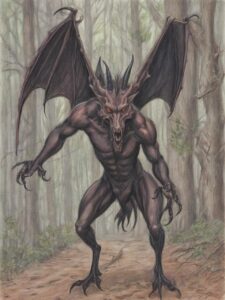
Many speculate that Benjamin Franklin, one of the founding fathers, could have initiated the legend of the Jersey Devil. It becomes apparent that Titan had a brother named Japhet Leeds, who, interestingly, happened to be married to a woman named Deborah. Historical records from 1736 reveal that Japhet had 12 children mentioned in his will. Given that this period coincided with the height of the rivalry between Benjamin Franklin and Titan Leeds, numerous people theorize that Franklin might have concocted the story as a means to tarnish the Leeds family reputation.
Several elements in the story lend credibility to this theory. Firstly, the timing aligns perfectly. The ‘Franklin vs. Leeds’ rivalry officially commenced in 1733, and the tale of the Jersey Devil’s creation unfolds in 1735, placing the birth of the creature squarely in the midst of the feud between the two families.
Another crucial factor is that, until the 1900s, people commonly referred to the Jersey Devil as the Leeds Devil. This indicates a definite connection between the two, suggesting that someone could have indeed fashioned the creature as a jest during the pinnacle of their animosity. Furthermore, the narrative includes the curse of ‘Mother Leeds’ for falling in love with a British soldier. Considering the Leeds family’s affiliation with the Loyalist party, this could have been a deliberate dig at the family.
However, the most compelling piece of evidence stems from the Leeds’ almanac itself. Before his demise, Titan well-documentedly redesigned the almanac cover to incorporate his family crest, prominently featuring the wyvern—a dragon-like creature characterized by leathery wings, clawed hands, and a forked tail. The resemblance between the wyvern and the Jersey Devil is striking, making it entirely plausible that Franklin leveraged this newly designed cover to further taunt the ‘traitorous Leeds family.’
Joseph Bonaparte Hunts the Jersey Devil
Joseph Bonaparte, the elder brother of ‘Emperor Napoleon Bonaparte,’ was also among those who believed in the Jersey Devil. He possessed land in Bordentown, New Jersey, situated within the Pine Barrens area. Various versions of the tale recount his encounter. Some assert that Joseph was actively hunting the Jersey Devil when he unexpectedly encountered the creature, which startled him with its existence. Others simply state that he was hunting on his property when he spotted the creature. This purportedly occurred in the year 1820.
Two decades later, there were additional sightings of the creature. It was held responsible for several livestock killings and the eerie screams that echoed through the woods. Despite these occurrences, there remained a lack of substantial evidence proving the creature’s actual existence.
Fact or Fiction? Regrettably, none of these encounters furnishes enough evidence or intricate details to substantiate the existence of the Jersey Devil. Many of the reported details could have easily corresponded to a known predator, which may have been mistaken for the cryptid in the heat of the moment.
The Jersey Devil Causes Widespread Panic in 1909
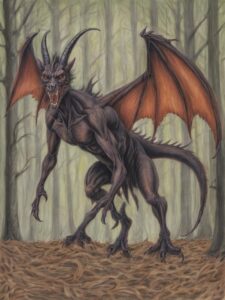
After a dormant period following the 1840s, the Jersey Devil reappeared in the 1870s, with several reported sightings during the winter months. However, it was the events of January 1909 that truly ignited panic and belief in the creature’s existence. During this week, from January 16th to January 23rd, thousands of New Jersey residents claimed to have spotted the Jersey Devil, causing widespread panic and excitement. This resurgence in sightings is a significant factor behind the Jersey Devil’s enduring popularity in modern times. Reports of the creature were so numerous that newspapers across the country published accounts, and local authorities took precautionary measures, suggesting a genuine concern for their citizens’ safety. Here is how the events unfolded:
On Saturday, January 16th, people witnessed the Jersey Devil flying over Woodbury, New Jersey. Although some initial panic occurred, observers initially considered it an isolated event, resembling previous tales. However, on the following day, there were more sightings in Bristol, along with the discovery of strange tracks matching the creature’s description.
The situation intensified on Monday, January 18th, when individuals found the creature’s tracks in Burlington, New Jersey—the very town where the tale of the Leeds family originated.
With numerous sightings accumulating, people began to question whether the Jersey Devil was more than just a cryptid born out of a feud between Loyalists and Patriots. The tracks in Burlington appeared to defy biological possibilities, intensifying the public’s fear and prompting them to take precautions.
On Tuesday the 19th, it became clear that the Jersey Devil was far from finished. At 2:30 in the morning, Nelson Evans and his wife spotted the creature outside their window. They described a beast nearly 3 ½ feet tall, with a peculiar head resembling a collie dog but with a horse-like face. Its neck was unnaturally long, and its wings spanned at least two feet. It walked on its back hooves and held its two front paws upright while moving. Although they managed to drive the creature away, the experience left them deeply frightened. Later that day, two hunters from Gloucester, their hometown, followed the creature’s tracks for 20 miles. They reported that it could leap over fences and squeeze through small gaps as narrow as 8 inches, corroborating earlier accounts from other towns.
The following day, residents of Haddonfield and Collingswood formed posses to hunt the cryptid. While a few of these posses spotted the creature flying toward Moorestown, they were unable to capture it.
The Devil Attacks
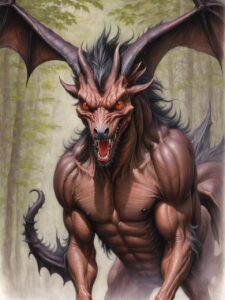
On Thursday, the 21st, tension escalated further among Pine Barrens residents when the Jersey Devil attacked a trolley car in Haddon Heights. Although it was eventually driven away, the widespread panic among the population was palpable. What compounded the fear was the fact that the creature’s last appearance was far from its final act.
Numerous poultry farmers in the area reported that something, most likely the Jersey Devil, had massacred all of their chickens. There were also witnesses who claimed to have seen the creature collide with electrical lines and continue flying as if unscathed. Later that day, a telegraph worker just outside of Atlantic City fired a shot at the creature. Regrettably, it managed to escape into the woods, although the worker reported that it was limping.
Nonetheless, the Jersey Devil pressed on with its assault on the Pine Barrens, appearing in Philadelphia, Pennsylvania, and Collingswood, New Jersey. People attempted to defend themselves by hurling projectiles at the creature, but according to reports, it remained unharmed.
Later in the day, a pet owner in Camden, New Jersey, witnessed the creature attempting to attack her dog. She managed to chase it away, but not before it tore a chunk of flesh from her beloved pet’s face. This incident became one of the most significant reports during the 1909 sightings because it marked the first time the Jersey Devil directly attacked a live animal.
This event instigated intense panic in the Pine Barrens area. Citizens stationed armed guards on trolleys to ensure citizen safety during transit. They organized more posses and hunting groups, all with the aim of capturing or killing the beast and ending the attacks for good. However, many people chose to take refuge in their homes until the attacks stopped or the Jersey Devil was eliminated. Fear of the cryptid led to numerous businesses and schools closing. Additionally, loggers and lumberjacks working in the Pine Barrens refused to return to work until they received assurance that the creature had been captured.
Friday the 22nd marked the final day of sightings, but the damage had already occurred. The people of the Pine Barrens had become thoroughly convinced of the Jersey Devil’s existence. Although reported sightings of the creature persist in modern times, as of now, none have matched the level of panic that gripped the region during the winter of 1909.
FAQ
What is the Jersey Devil?
The Jersey Devil is a mythical creature from American folklore, said to inhabit the Pine Barrens of New Jersey. It is described as a winged, hoofed, and horned creature and is the subject of various legends and sightings, though no concrete evidence of its existence exists.
What does the Jersey Devil look like?
The Jersey Devil is typically described as having bat-like wings, hooves similar to that of a horse or goat, antler-like horns on its head, a long, forked tail, sharp claws on its hands, a head resembling that of a horse in some accounts, leathery or reptilian skin, and in some accounts, mangy or unkempt fur.
What are the origins of the Jersey Devil legend?
The origins of the Jersey Devil legend date back to the early 18th century in the Pine Barrens of New Jersey. The most widely recognized version of the story attributes the creature to a woman named Mother Leeds, who was rumored to be a witch. According to the legend, she gave birth to her thirteenth child under a curse, and the child transformed into the Jersey Devil shortly after its birth.
Are there any famous encounters with the Jersey Devil?
Yes, there have been reported encounters with the Jersey Devil, with one of the most significant occurring during the 1909 sightings. The creature was witnessed flying over various towns in New Jersey, and there were reports of attacks on livestock and even a dog.
Is there any concrete evidence of the Jersey Devil's existence?
Despite numerous sightings and reports, there is no concrete evidence to substantiate the existence of the Jersey Devil. Many of the reported details could have been attributed to known predators, and the legend remains a part of folklore and cryptozoology.
